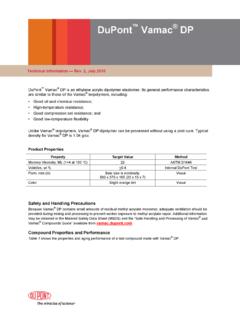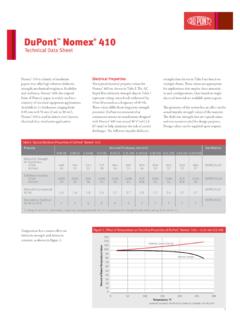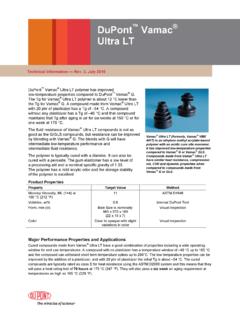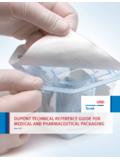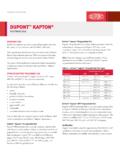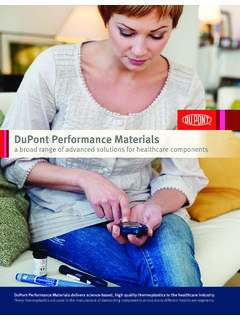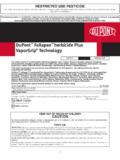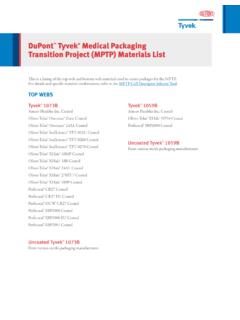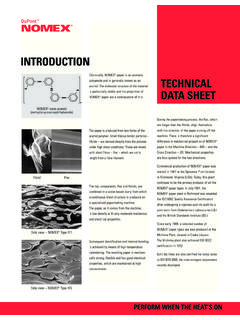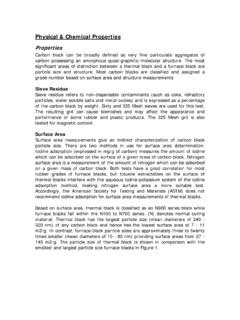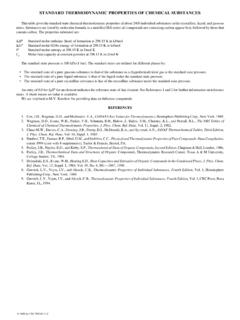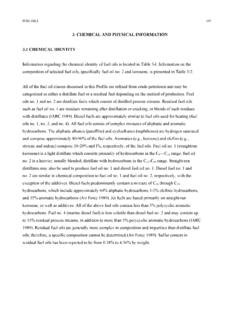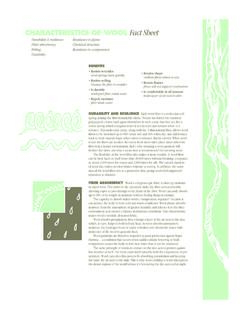Transcription of DUPONT KAPTON
1 DUPONT KAPTON is used in applications such as the solar array and for thermal management in the United States space KAPTON SUMMARY OF PROPERTIESG eneral Information ..2 Physical and Thermal properties ..3 Mechanical properties ..5 Hydrolytic Stability ..6 Dimensional Stability ..7 Thermal Aging ..7 Electrical properties ..10 Effect of Humidity ..11 Effect of Temperature ..12 Effect of Frequency ..13 Corona Life ..14 Chemical properties ..15 Radiation Resistance ..16 KAPTON Film Type Information ..17 Nominal Construction, Type FN ..18 Safety and Handling ..19 Soldering and Hot Wire Stripping ..19 Welding and Flame Cutting.
2 19 Scrap Disposal ..19 Fire Hazards ..19 Static Electricity ..192 GENERAL INFORMATIONK apton polyimide film possesses a unique combination of properties that make it ideal for a variety of applications in many different industries. The ability of KAPTON to maintain its excellent physical, electrical, and mechanical properties over a wide temperature range has opened new design and application areas to plastic films. KAPTON is synthesized by polymerizing an aromatic dianhydride and an aromatic diamine. It has excellent chemical resistance; there are no known organic solvents for the film. KAPTON is self extinguishing as it has the highest UL-94 flammability rating: V-0.
3 The outstanding properties of KAPTON permit it to be used at both high and low temperature extremes where other organic polymeric materials would not be functional. Adhesives are available for bonding KAPTON to itself and to metals, various paper types, and other films. KAPTON polyimide film can be used in a variety of electrical and electronic insulation applications: wire and cable tapes, formed coil insulation, substrates for flexible printed circuits, motor slot liners, magnet wire insulation, transformer and capacitor insulation, magnetic and pressure-sensitive tapes, and tubing. Many of these applications are based on the excellent balance of electrical, thermal, mechanical, physical, and chemical properties of KAPTON over a wide range of temperatures.
4 It is this combination of useful properties at temperature extremes that makes KAPTON a unique industrial types of KAPTON are described in this bulletin: KAPTON Type HN, all-polyimide film, has been used successfully in applications at temperatures as low as -269 C (-452 F) and as high as 400 C (752 F). Type HN film can be laminated, metallized, punched, formed, or adhesive coated. It is available as m ( mil), m ( mil), 25 m (1 mil), 50 m (2 mil), 75 m (3 mil), and 125 m (5 mil) films. KAPTON Type HPP-ST, all-polyimide film with all of the properties of Type HN, plus superior dimensional stability and modified surface for better adhesion.
5 Type HPP-ST is available as m ( mil), 25 m (1 mil), 50 m (2 mil), 75 m (3 mil), and 125 m (5 mil) films. KAPTON Type FN, a Type HN film coated or laminated on one or both sides with FEP fluoropolymer resin, imparts heat sealability, provides a moisture barrier, and enhances chemical resistance. Type FN is available in a number of combinations of polyimide and FEP thicknesses (see Table 16).Note: In addition to these three types of KAPTON , films are available with the following attributes: Antistat Thermally conductive Polyimides for fine line circuitryDUPONT KAPTON SUMMARY OF properties Cryogenic insulation Corona resistant Pigmented for color Conformable Other films tailored to meet customers needsData for these films are covered in separate product bulletins, which can be obtained from your DUPONT withstands the harsh chemical and physical demands on diaphragms used in automotive polyimide films retain their physical properties over a wide temperature range.
6 They have been used in field applications where the environmental temperatures were as low as -269 C (-52 F) and as high as 400 C (752 F). Complete data are not available at these extreme conditions, and the majority of technical data presented in this section falls in the 23 to 200 C (73 to 392 F) KAPTON SUMMARY OF PROPERTIEST able 1. Physical properties of KAPTON Type 100 HN Film, 25 m (1 mil)Physical PropertyTypical Value atTest Method23 C (73 F)200 C (392 F) Ultimate Tensile Strength, MPa (psi)231 (33,500)139 (20,000)ASTM D-882-91, Method A*Yield Point at 3%, MPa (psi)69 (10,000)41 (6000)ASTM D-882 Stress to Produce 5% Elongation, MPa (psi)90 (13,000)61 (9000)ASTM D-882 Ultimate Elongation, %7283 ASTM D-882 Tensile Modulus, GPa (psi) (370,000) (290,000)ASTM D-882 Impact Strength, N cm (ft lb)78( ) DUPONT Pneumatic Impact TestFolding Endurance (MIT), cycles285,000 ASTM D-2176 Tear Strength Propagating (Elmendorf), N (lbf) ( )
7 ASTM D-1922 Tear Strength Initial (Graves), N (lbf) ( )ASTM D-1004 Density, g/cc or D-1505 Coefficient of Friction Kinetic (Film-to-Film) D-1894 Coefficient of Friction Static (Film-to-Film) D-1894 Refractive Index (Sodium D Line) D-542 Poisson s Three Samples Elongated at 5%, 7%, 10%Low Temperature Flex LifePassIPC TM 650, Method *Specimen Size: 225 x 150 mm (1 x 6 in); Jaw Separation: 100 mm (4 in); Jaw Speed: 50 mm/min (2 in/min); Ultimate refers to the tensile strength and elongation measured at 2. Thermal properties of KAPTON Type 100 HN Film, 25 m (1 mil)Thermal PropertyTypical ValueTest ConditionTest MethodMelting PointNoneNoneASTM E-794 (1989)Thermal Coefficient of Linear Expansion 20 ppm/ C (11 ppm/ F)-14 to 38 C (7 to 100 F)ASTM D-696 Coefficient of Thermal Conductivity, W/m K calcm sec 10-4296 K23 CASTM F-433 (1987)Specific Heat, J/g K (cal/g C) ( )Differential CalorimetryFlammability94V-0UL-94 (2-8-85)
8 Shrinkage, % min at 150 C120 min at 400 CIPC TM 650, Method D-5214 Heat SealabilityNot Heat SealableLimiting Oxygen Index, %37 ASTM D-2863 Solder FloatPassIPC TM 650, Method GenerationDM = <1 NBS Smoke ChamberNFPA-258 Glass Transition Temperature (Tg)A second order transition occurs in KAPTON between 360 C (680 F) and 410 C (770 F) and is assumed to be the glass transition temperature. Different measurement techniques produce different results within the above temperature 3. Physical and Thermal properties of KAPTON Type HPP-ST FilmPropertyTypical Value for Film ThicknessTest Method25 m (1 mil)50 m (2 mil)75 m (3 mil)125 m (5 mil)Ultimate Tensile Strength, MPa (psi)231 (33,500)234 (34,000)231 (33,500)231 (33,500)ASTM D-882 Ultimate Elongation, %72828282 ASTM D-882 Tear Strength Propagating (Elmendorf), ASTM D-1922 Tear Strength Initial (Graves), D-1004 Folding Endurance (MIT), 103 cycles2855565 ASTM D-2176 Density, g/cc or D-1505 Flammability94V-094V-094V-094V-0UL-94 (2-8-85)Shrinkage, %, 30 min at 150 C (302 F)
9 TM 650 Method Oxygen Index, %37434645 ASTM D-2863 Table 4. Physical properties of KAPTON Type FN Film*PropertyTypical Value for Film Type**120FN616150FN019250FN029 Ultimate Tensile Strength, MPa (psi)23 C (73 F)200 C (392 F)207 (30,000)121 (17,500)162 (23,500)89 (13,000)200 (29,000)115 (17,000)Yield Point at 3%, MPa (psi)23 C (73 F)200 C (392 F)61 (9000)42 (6000)49 (7000)43 (6000)58 (8500)36 (5000)Stress at 5% Elongation, MPa (psi)23 C (73 F)200 C (392 F)79 (11,500)53 (8000)65 (9,500)41 (6000)76 (11,000)48 (7000)Ultimate Elongation, %23 C (73 F)200 C (392 F)7580707585110 Tensile Modulus, GPa (psi)23 C (73 F)200 C (392 F) (360,000) (235,000) (330,000) (165,000)
10 (380,000) (200,000)Impact Strength at 23 C (73 F), N cm (ft lb)78 ( ) ( ) ( )Tear Strength Propagating (Elmendorf), N (lbf) ( ) ( ) ( )Tear Strength Initial (Graves), N (lbf) ( ) ( ) ( )Polyimide, wt%FEP, wt%802057437327 Density, g/cc or *Test methods for Table 4 are the same as for Table 1.**Because a number of combinations of polyimide film and fluorocarbon coating add up to the same total gauge, it is necessary to distinguish among them. A three-digit system is used in which the middle digit represents the nominal thickness of the base KAPTON film in mils. The first and third digits represent the nominal thickness of the coating of FEP fluoropolymer resin in mils.
